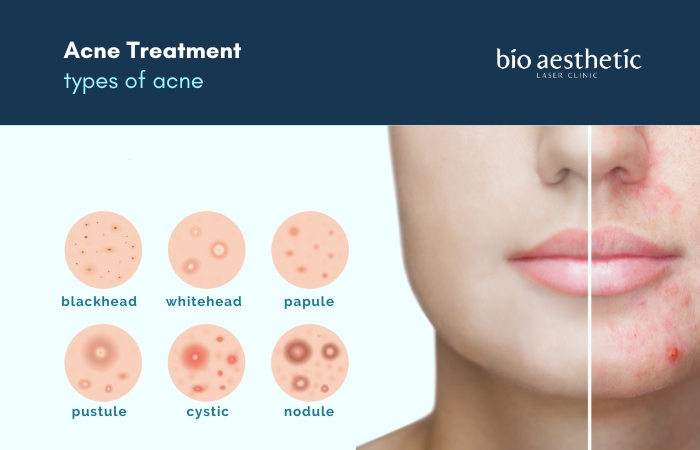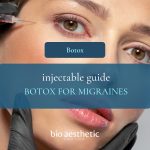Acne: Treatment, Types, Diagnosis and Prevention
Acne is a common skin condition that affects millions of people worldwide.
It can occur at any age, though it is most prevalent during puberty.
It can manifests as pimples, blackheads, whiteheads, and sometimes cysts or nodules.
This guide will provide a comprehensive understanding of acne, including its causes, types, treatments, and prevention strategies.
What is Acne?
Acne is a common skin condition that occurs when hair follicles become clogged with oil, dead skin cells, and bacteria.
This blockage leads to the formation of various types of blemishes, including pimples, blackheads, whiteheads, and sometimes cysts or nodules.
Breakouts most commonly appear on the face, chest, back, and shoulders, areas where sebaceous (oil) glands are most prevalent.
Understanding the Causes of Acne
Acne occurs when hair follicles become clogged with oil and dead skin cells. Several factors contribute to the development of acne, including:
- Hormonal Changes: Androgens increase during puberty, menstrual cycle, pregnancy hormones and Polycystic ovary syndrome (PCOS).
- Diet: Certain foods, such as dairy products and carbohydrate-rich foods.
- Stress: Stress can worsen existing skin conditions.
- Medications: Some drugs, including corticosteroids and lithium.
- Genetics: If your parents had oily skin, you’re likely to develop it too.
- Skin Care Products: Oily or greasy cosmetic and hair products can clog pores
- Environment Factors: Humidity, sweat and pollution can contribute to inflammation
Specific Forms of Acne
Acne can appear in various forms and locations, each requiring specific approaches for management and treatment.

Cystic Acne
Cystic acne is a severe form of breakouts that involves large, painful cysts deep within the skin.
Due to bacteria, oil, and dry skin cells that get trapped in the pores.
Treatment:
Medications such as isotretinoin
Corticosteroid injections
Oral antibiotics

Back Acne
Back acne, or “bacne,” occurs when sweat, oil, and dead skin cells clog pores on the back.
Often triggered by physical activity and tight clothing.
Treatment:
Benzoyl peroxide or salicylic acid washes.
Loose, breathable clothing.
Body chemical peel

Hormonal Acne
Fluctuations in hormones (androgens), which increase oil production.
Common on the lower face, jawline, and neck, often around the menstrual cycle in women.
Treatment:
Oral contraceptives
Anti-androgen medications
Topical retinoids help unclog pores.

Fungal Acne
Fungal acne, or malassezia folliculitis, is caused by an overgrowth of yeast in the hair follicles.
Similar to bacterial but requires different treatments.
Treatment:
Antifungal treatments
Avoiding heavy moisturizers and oils
Keeping the skin dry and clean

Nodular Acne
Nodules involves large, hard lumps beneath the surface of the skin.
These nodules are painful and can cause significant acne scarring.
Treatment:
Oral antibiotics to reduce inflammation
Isotretinoin for severe cases.
Salicylic Acid Chemical Peel

Scalp Acne
Scalp pimples occurs on the scalp and along the hairline.
Sweating or hair products that trap moisture and bacteria can be the cause.
Treatment:
Medicated shampoos with salicylic acid
Avoid heavy hair products.
Maintaining scalp hygiene.

Butt Acne
Butt pimples (folliculitis), occurs when the hair follicles become inflamed.
Often caused by friction from clothing, sweating, and bacteria.
Treatment:
Wearing breathable clothing
Using antibacterial cleansers.
Applying topical antibiotics or benzoyl peroxide.

Chin Acne
Chin pimples is often associated with hormonal changes and stress.
It appears as red, inflamed pimples or cysts on the chin area.
Treatment:
Oral contraceptives.
Topical retinoids help clear pores.
Salicylic Acid Chemical Peel
Effective Acne Treatment
Depending on the severity of the condition,. Here’s a guide on mild, moderate, and severe acne treatments.
Mild Acne
Typically consists of blackheads, whiteheads, and a few pimples. It can often be managed with over-the-counter treatments and good skincare practices.
1. Topical Treatments:
- Benzoyl Peroxide: Reduces oil production and kills bacteria.
- Salicylic Acid: Helps unclog pores and reduce inflammation.
- Alpha Hydroxy Acids (AHAs): Such as glycolic acid, promote cell turnover and help prevent clogged pores.
2. Gentle Skincare Routine:
- Cleanser: Use a gentle, non-comedogenic cleanser twice daily.
- Moisturizer: Opt for an oil-free, non-comedogenic moisturizer to keep the skin hydrated.
- Sun Protection: Use a broad-spectrum sunscreen to prevent hyperpigmentation and skin damage.
3. Lifestyle Changes:
- Diet: Reduce intake of high-glycemic foods and dairy products.
- Hygiene: Keep hands off the face and regularly clean items that come into contact with the skin (e.g., phone, pillowcases).
Moderate Acne
Moderate acne includes a higher number of inflammatory lesions, such as papules and pustules, and may require prescription treatments in addition to over-the-counter options.
1. Prescription Topical Treatments:
- Topical Retinoids: Such as tretinoin, adapalene, or tazarotene, promote cell turnover and prevent clogged pores.
- Topical Antibiotics: Such as clindamycin or erythromycin, reduce bacteria and inflammation.
2. Oral Medications:
- Oral Antibiotics: Such as doxycycline or minocycline, reduce bacteria and inflammation.
- Hormonal Treatments for Women: Oral contraceptives or anti-androgens like spironolactone can help regulate hormones.
4. Professional Treatments:
- Chemical Peels: Performed by dermatologists to remove the top layer of skin and unclog pores.
- Carbon Laser Peel: Reduces bacteria and inflammation through specific wavelengths of light.
Severe Acne
Includes nodules, cysts, and extensive inflammation. It often requires more aggressive and long-term treatments under the supervision of a dermatologist.
1. Oral Medications:
- Isotretinoin: A powerful medication for severe, resistant cases. It reduces oil production, unclogs pores, and decreases inflammation. Requires close monitoring due to potential side effects.
- Oral Antibiotics: Used for moderate to severe cases, often combined with topical treatments.
2. Professional Procedures:
- Corticosteroid Injections: Reduce inflammation and pain in cysts and nodules.
- Laser and Light Therapy: Target bacteria and reduce inflammation.
- Drainage and Extraction: Performed by a doctor to remove large cysts.
- Salicylic Acid Peel: Clear off bacteria prevent future breakouts
Prevention Tips for Acne
Preventing acne involves adopting a consistent skincare routine and making lifestyle changes:
- Cleanse Regularly: Wash your face twice daily with a gentle cleanser.
- Avoid Harsh Products: Steer clear of products that irritate your skin.
- Keep Hands Off Your Face: Avoid touching your face to reduce the spread of bacteria.
- Use Non-Comedogenic Products: Choose skincare and makeup products that won’t clog pores.
- Maintain a Healthy Diet: Eat a balanced diet rich in fruits, vegetables, and whole grains.
- Manage Stress: Practice stress-reducing activities like yoga and meditation.
Home Remedies for Acne
While professional treatments are often necessary, some home remedies can help alleviate the symptoms:
- Tea Tree Oil: Has antimicrobial properties that reduce pimples.
- Aloe Vera: Soothes the skin and reduces inflammation.
- Apple Cider Vinegar: Balances the skin’s pH and has antibacterial properties.
- Honey and Cinnamon Mask: Combats bacteria and reduces inflammation.
BOOK NOW PAY LATER.
Call Us Today! +65 6333 4566 • hello@bioaesthetic.com.sg
ABOUT BIO AESTHETIC LASER CLINIC

Bio Aesthetic Laser Clinic is a multi award winning aesthetic clinic in Singapore specialising in treatments such as:
MORE QUESTIONS?
Feel free to Call Us / Whatsapp Us. We are more than happy to address your concerns































































